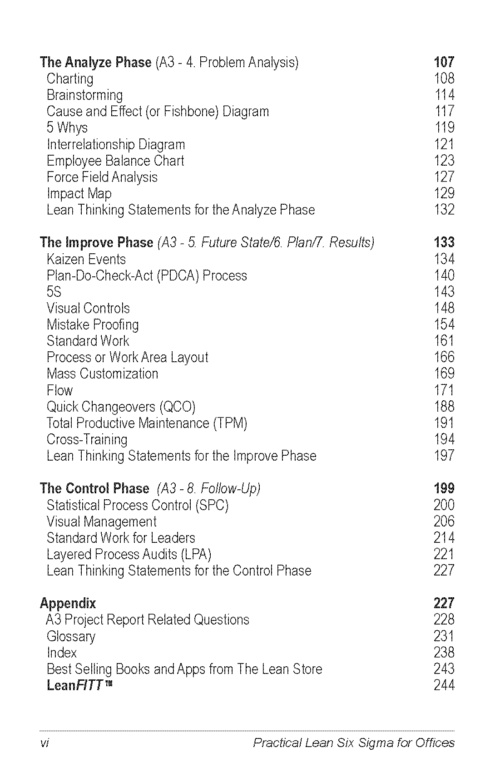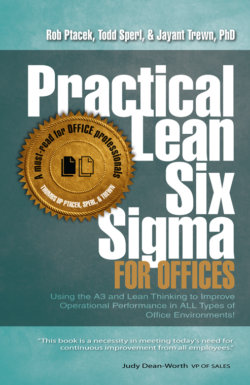By: Rob Ptacek, Todd Sperl, Jayant Trewn, PhD
This book bridges the gap between a highly quantitative analysis of a process that requires extensive training (i.e., Six Sigma certification) and a more simplified approach that can be used and understood by the masses (i.e., Lean thinking). The goal of this book is to make the methods and tools of Lean and Six Sigma accessible to more people and provide a common sense or “practical” approach to problem solving and continuous improvement. This book is intended to be used by Sigma Belt Levels, Lean Senseis (i.e., teachers), Continuous Improvement Specialists, front-line managers, and supervisors of departments and work groups, and improvement team members in their efforts to improve all types of administrative processes while reducing waste and variations, and engaging employees. The Lean Six Sigma tools and concepts are presented relative to the A3 road map to provide a definitive how-to guide to problem solving and continuous improvement (Kaizen) initiatives.
The powerful Lean and Six Sigma improvement methods and tools that have proven phenomenally successful in the manufacturing, healthcare, financial services, etc. industries, now have been translated into a practical form for service organizations. These tools and concepts will help service organizations maintain a competitive edge in today’s fast-paced world.
-
Sale!
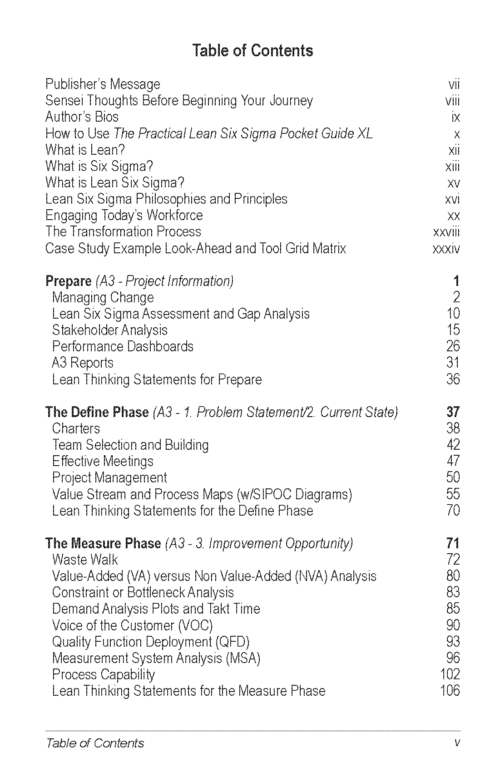
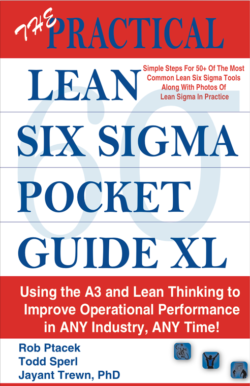 By: Rob Ptacek, Todd Sperl, Jayant Trewn (PhD), and Deborah Salimi (PhD)Note: Currently out of stock for hard copy. We Print-On-Demand for this title of quantities of 20 or more. Please call 734-475-4301 to place your order.The Practical Lean Six Sigma Pocket Guide XL bridges the gap between a highly quantitative analysis of a process that requires extensive training (i.e., Six Sigma certification) and a more simplified approach that can be used and understood by the masses (i.e., Lean thinking). This book make the methods and tools of Lean and Six Sigma accessible to more people and provide a common sense or “practical” approach to problem solving and continuous improvement. Over 40 of the most common Lean Sigma tools are clearly define with a step-by-step approach, checklists, forms and worksheet examples, as well as case study examples from office/service (administrative), retail, healthcare, financial, travel services, and manufacturing. The broad examples will allow employees to fully understand the “practicality” and universal application these tools provide. Therefore, with that information, the ability to apply the tool or concept to their processes will be that much more successful.
By: Rob Ptacek, Todd Sperl, Jayant Trewn (PhD), and Deborah Salimi (PhD)Note: Currently out of stock for hard copy. We Print-On-Demand for this title of quantities of 20 or more. Please call 734-475-4301 to place your order.The Practical Lean Six Sigma Pocket Guide XL bridges the gap between a highly quantitative analysis of a process that requires extensive training (i.e., Six Sigma certification) and a more simplified approach that can be used and understood by the masses (i.e., Lean thinking). This book make the methods and tools of Lean and Six Sigma accessible to more people and provide a common sense or “practical” approach to problem solving and continuous improvement. Over 40 of the most common Lean Sigma tools are clearly define with a step-by-step approach, checklists, forms and worksheet examples, as well as case study examples from office/service (administrative), retail, healthcare, financial, travel services, and manufacturing. The broad examples will allow employees to fully understand the “practicality” and universal application these tools provide. Therefore, with that information, the ability to apply the tool or concept to their processes will be that much more successful.Your eBook will be provided as a downloaded file.
The download PDF book provided is to be distributed to the quantity purchased. Unauthorized copying or sharing is not permitted. Please email info@theleanstore.com or call 734-475-4301 if you have any questions on the ebook(s) purchase. EG., if you purchase 5 copies of a book will allow you to distribute the PDF to 5 users. -
Sale!
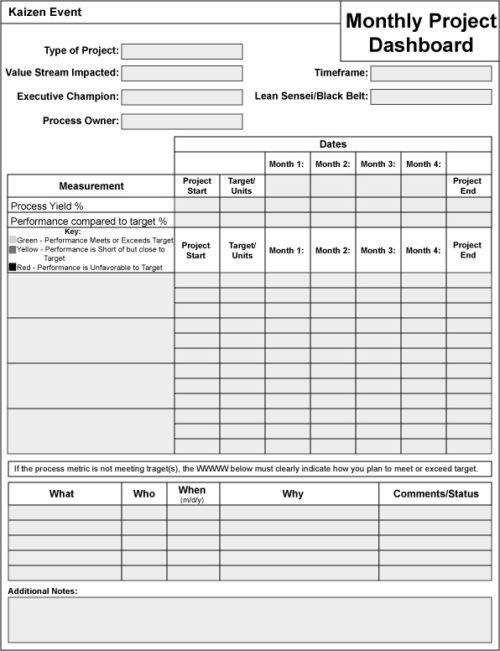
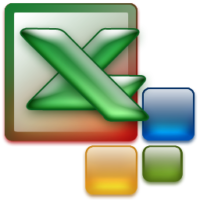 The Kaizen Demystified Worksheets allow you to customize the tools, concepts, practices, and worksheets demonstrated in the Kaizen Demystified book. These 46 electronic worksheets will allow for an effective and efficient application of engaging people in a Kaizen Event. Delivered as customizable Excel worksheets.
The Kaizen Demystified Worksheets allow you to customize the tools, concepts, practices, and worksheets demonstrated in the Kaizen Demystified book. These 46 electronic worksheets will allow for an effective and efficient application of engaging people in a Kaizen Event. Delivered as customizable Excel worksheets. -
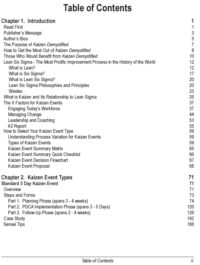
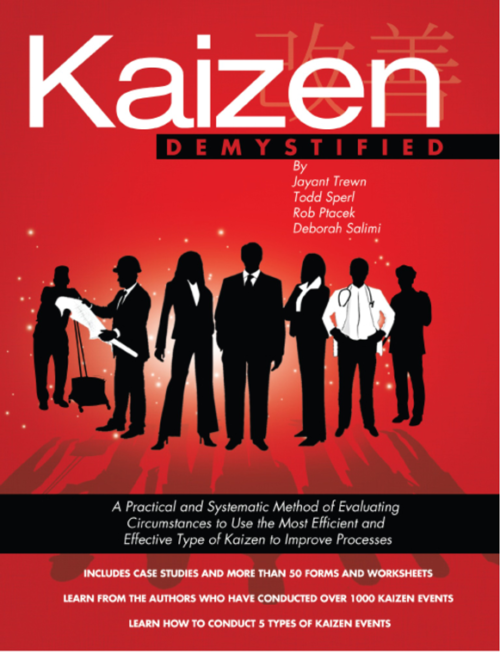 By: Jayant Twewn (PhD), Todd Sperl, Rob Ptacek, and Deborah Salimi (PhD)
By: Jayant Twewn (PhD), Todd Sperl, Rob Ptacek, and Deborah Salimi (PhD)
We are pleased to present Kaizen Demystified, perfectly timed for today s ever-changing and ever-demanding business environment requiring improved processes. Whether your industry is manufacturing, healthcare, financial, education, armed forces, services, government, or the construction industry, or, you are a manager, supervisor, team leader, or a front-line worker, this book will provide new insights and ideas for managing and facilitating continuous improvement and problem solving projects (i.e., Kaizen Events). Kaizen Demystified provides a simple and practical approach detailing five distinct methods on how Lean (and Six Sigma) tools and concepts can quickly and efficiently be applied and managed to solve business problems and improve processes. The five types of Kaizen Events detailed in this book are the: (1) Standard 5 Day Kaizen Event, also referred to as a Kaizen Blitz or Rapid Improvement Event, (2) Rolling Kaizen Event, (3) Web Based Kaizen Event, (4) Today's Kaizen Event, and (5) Wiki (or Quick) Kaizen Event. Each type will be thoroughly explained to demystify what it may mean for you. Kaizen Event Leadership is thoroughly explored in a separate chapter/section that relates to all types of Kaizen Events. It provides a listing of the common issues facing the leader of a Kaizen Event as well as suggested how-to leadership skills to address those issues. This is one of the most important aspects of leading any type of Kaizen Event. -
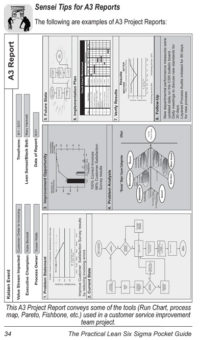
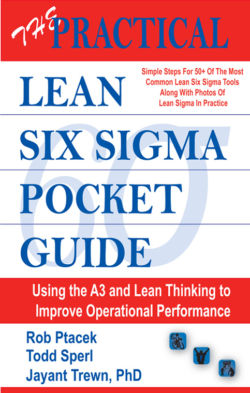 By: Rob Ptacek, Todd Sperl, and Jayant Trewn (PhD) The Practical Lean Six Sigma Pocket Guide is designed as a convenient, quick reference, and, most importantly, a step-by-step implementation guide. You can put your finger on any tool within a matter of seconds! Find the right tool for the right initiative by using the: - Navigate the Prepare - Define - Measure - Analyze - Improve - Control right side book tabs. - Complete the A3 Project Report as you learn and apply the various tools on the project by:
By: Rob Ptacek, Todd Sperl, and Jayant Trewn (PhD) The Practical Lean Six Sigma Pocket Guide is designed as a convenient, quick reference, and, most importantly, a step-by-step implementation guide. You can put your finger on any tool within a matter of seconds! Find the right tool for the right initiative by using the: - Navigate the Prepare - Define - Measure - Analyze - Improve - Control right side book tabs. - Complete the A3 Project Report as you learn and apply the various tools on the project by:- Go to the tab in the book that corresponds to the D-M-A-I-C Phase you are working on.
- Read about the tools for that phase of your project.
- Apply the appropriate tools.
- Complete the relevant section of the A3 Project Report.
- Repeat 1 - 4 as you navigate through the phases and complete your project.
-

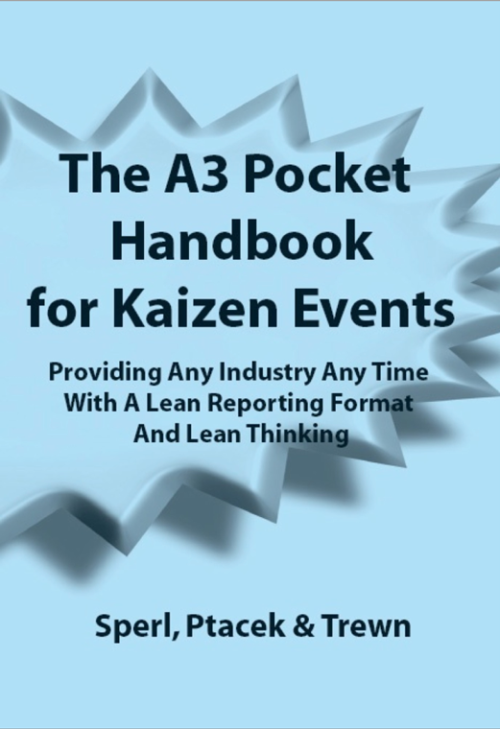 By: Todd Sperl, Rob Ptacek, Jayant Trewn (PhD)The A3 Pocket Handbook for Kaizen Events allows team members to be literally and figuratively on the same page when participating in an improvement event. This allows more ownership, while at the same time preserving organizational knowledge. The improvement methodology used (i.e., Six Sigma D-M-A-I-C, PDCA, etc.) will relate to the A3 Report that is conveyed in this publication. (The A3 Report is designed to help you “tell the story” in a logical and visual way and act as a road map for continuous improvement and problem solving initiatives.) The purpose of this pocket handbook is to:
By: Todd Sperl, Rob Ptacek, Jayant Trewn (PhD)The A3 Pocket Handbook for Kaizen Events allows team members to be literally and figuratively on the same page when participating in an improvement event. This allows more ownership, while at the same time preserving organizational knowledge. The improvement methodology used (i.e., Six Sigma D-M-A-I-C, PDCA, etc.) will relate to the A3 Report that is conveyed in this publication. (The A3 Report is designed to help you “tell the story” in a logical and visual way and act as a road map for continuous improvement and problem solving initiatives.) The purpose of this pocket handbook is to:- Ensure all team members have a quick reference for Lean Six Sigma definitions.
- Compliment, as a mini-workbook, the Practical Lean Six Sigma for Healthcare and The Lean Six Sigma Pocket Guide XL books as well as any other training materials used in an improvement event.
- Provide a road map for continuous improvement projects if no other methodology (i.e., PDCA, D-M-A-I-C, etc.) is used.
- Provide Lean Thinking Statement assessments at the end of each section for employees to “think” Lean and continue their engagement.
- Be a repository of thoughts, ideas, and any action items that may be assigned, etc.
- To retain organizational knowledge by being a personal detailed log of the Kaizen Event to be shared and/or referenced later.
-
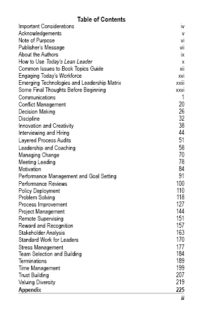
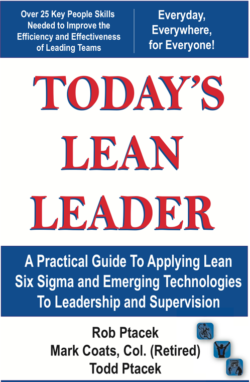 By: Rob Ptacek, Mark Coats, Col. (Retired, US Army), Todd PtacekToday's Lean Leader is designed for use as a quick and convenient reference, or as a training guide to improve your effectiveness in leading, supervising, and coaching employees. It provides valuable insight into the How To's of leadership and supervision. Today's Lean Leader can be used in a variety of ways, some of which are: (1)The guide is valuable for the new or veteran leader - supervisor (2) Remarkably, the guide in the hands of the workforce makes the task of leading and supervising all the easier when everyone is on the same page on these basic principles.
By: Rob Ptacek, Mark Coats, Col. (Retired, US Army), Todd PtacekToday's Lean Leader is designed for use as a quick and convenient reference, or as a training guide to improve your effectiveness in leading, supervising, and coaching employees. It provides valuable insight into the How To's of leadership and supervision. Today's Lean Leader can be used in a variety of ways, some of which are: (1)The guide is valuable for the new or veteran leader - supervisor (2) Remarkably, the guide in the hands of the workforce makes the task of leading and supervising all the easier when everyone is on the same page on these basic principles. -
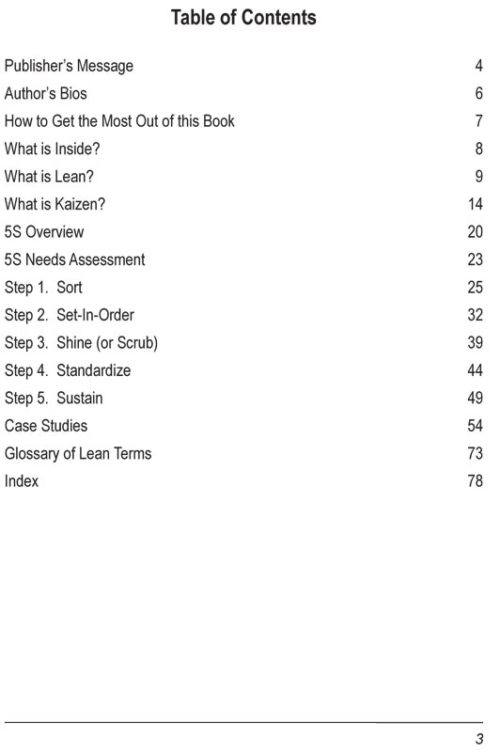
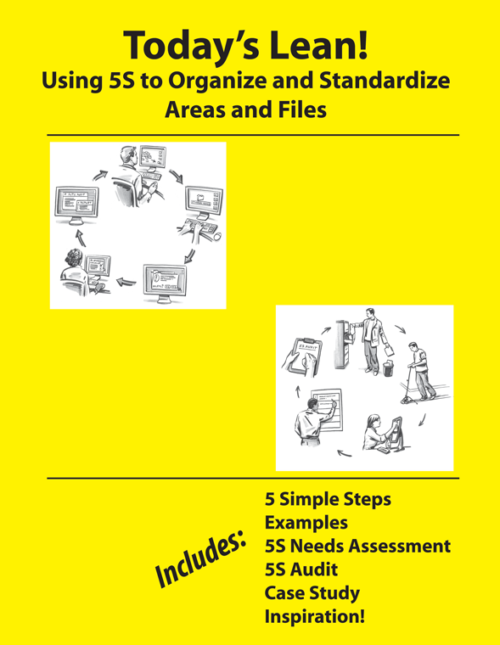 By: Rob Ptacek and Jaideep Motwani (Ph.D.)
By: Rob Ptacek and Jaideep Motwani (Ph.D.)
Note: Currently out of stock for hard copy. We Print-On-Demand for this title of quantities of 50 or more. Please call 734-475-4301 to place your order.Today’s Lean! Using 5S to Organize and Standardize Areas and Files is another book from the Today’s Lean! series published by MCS Media, Inc. It has been suggested by you, our readers, that you would like Lean and Six Sigma information to be more succinct and at your fingertips, thus allowing for a single tool or concept to be easily accessible (i.e., as a pocket guide and not a manual). Therefore, the Today’s Lean! series of books provide:Your eBook will be provided as a downloadable file.
The downloadable PDF book provided is to be distributed to the quantity purchased. Unauthorized copying or sharing is not permitted. Please email info@theleanstore.com or call 734-475-4301 if you have any questions on the ebook(s) purchase. EG., purchasing 5 copies of a book will allow you to distribute the PDF to 5 users.- Concise content on a one main Lean or Six Sigma tool or concept
- Numerous case studies, worksheets, and examples from all types of industries
- Availability as a pocket guide or ebook
- A standard format
- An avenue to update content immediately via your feedback and input (via ebook updates)
- An inspiration for you to implement something similar
-
Sale!
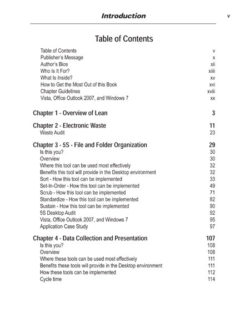
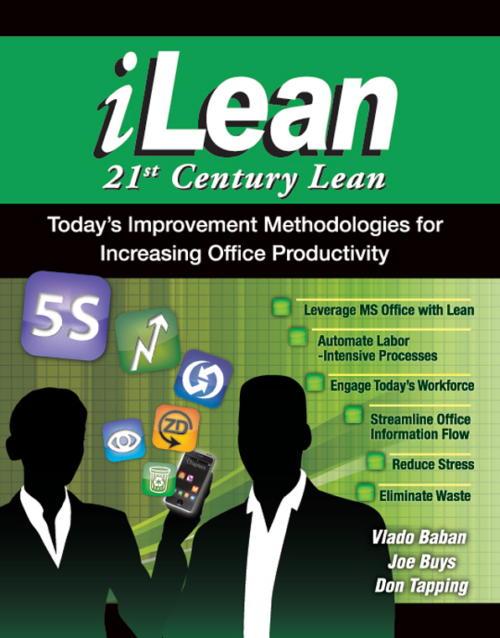 By: Vlado Baban, Joe Buys, and Don Tapping
By: Vlado Baban, Joe Buys, and Don Tapping
iLean's content will provide actual case studies, application examples, and working macros that have proven successful in improving information flow in all types of environments. iLean was arranged in a format that should provide you with enough detailed guidance (step-by-step instructions) to apply a similar-type Lean practice to your work process. Starting with Chapter 3, each chapter begins with a section titled Is this you? which was specifically designed to assist you in determining if that chapter has immediate relevancy to your current work challenges. Subsequently, it is suggested that a formal standard improvement methodology, Six Sigma's Design-Measure-Analyze-Improve-Control (D-M-A-I-C), Edward Deming's Plan-Do-Check-Act (PDCA) or some other similar methodology be used if a formal structure is required and/or more statistical analysis needs is required. However, many of the concepts and tools presented throughout this book can be implemented by an individual worker and, therefore, will not require a formal process (other than good project management skills). Microsoft s Office suite of products of Word, Excel, and Outlook, as well as Open Source applications of vTiger, Google Docs, and Huddle, are referenced throughout this book to provide an overall understanding of how Lean can be used to move information faster and more accurately than ever before. In doing so, you will be able to reduce inter-office dependencies, delays, and errors that may be present in your current business processes. -
Sale!
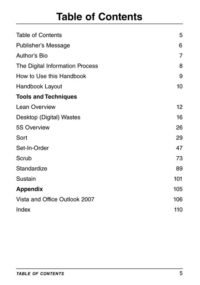
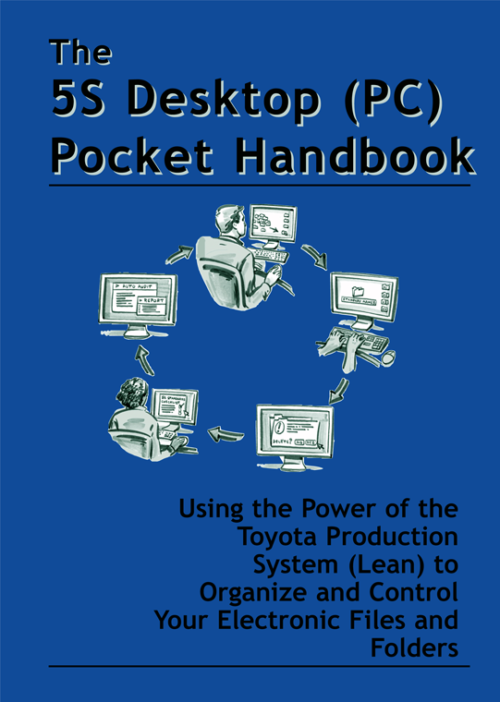 By: Vlado Baban
By: Vlado Baban
The 5S Desktop (PC) Pocket Handbook is a step-by-step guide for the implementation of 5S to all your electronic files. The XP version of Windows Explorer and the Office 2003 software suite were the versions used in creating this handbook. This handbook is designed to be:- An implementation guide. This handbook steps you through each phase of the 5S process. Examples are shown to assist you in this process. No two file systems (Desktops) are the same; therefore, use the examples as a guide when you apply that phase or step to your Desktop.
- A Lean beginning. 5S is a fundamental Lean tool and is considered the foundation for additional Lean tool application. Once 5S has been implemented and results have been obtained, there will be a need to integrate more Lean tools into your Desktop environment.
- A spark for the department. Once everyone understands the basic premise of Lean and 5S, then that understanding can serve as a catalyst for a more comprehensive application of Lean tools. (iLean and Lean Office Demystified II are available books on how additional Lean tools can be applied to your Desktop environment.)
- A bridge for improved performance. It is often stated that the average person at work today has nearly 80 emails to deal with on a daily basis. This, along with the other application files, can at times be overwhelming for the individual. Using 5S for organizing your emails, as well as the other application files, will greatly assist in managing this barrage of information. Implementing 5S to your files and folders will allow for a more stress-free workplace.
-
Sale!

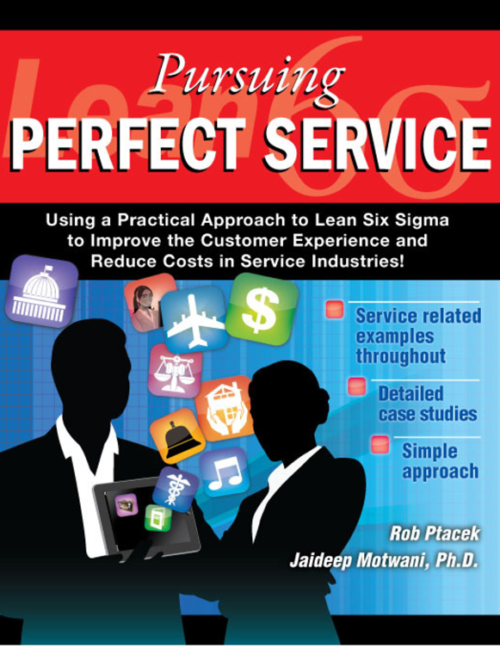 By: Rob Ptacek and Jaideep Motwani (Ph.D)
By: Rob Ptacek and Jaideep Motwani (Ph.D)
Note: Currently out of stock. Orders placed today will ship within 2 weeks! Pursuing Perfect Service is a comprehensive and detailed set of instructions on how to implement Lean and Six Sigma tools and concepts in a variety of environments. It will provide the solid foundation upon which Lean Sigma tools can be applied in any service organization. Service providers are continually processing daily requests and must know how to identify client needs and expectations, how to best satisfy their needs, and how to do it at the lowest possible cost. This book is a step-by-step implementation guide for continuous improvement while creating a solid foundation upon which to build a service excellence culture. Pursuing Perfect Service also provides insights and examples on how Information Technology can be used to improve data and information flow to enhance the overall client experience, while ensuring organizational profitability. -
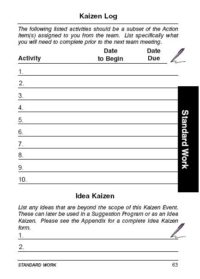
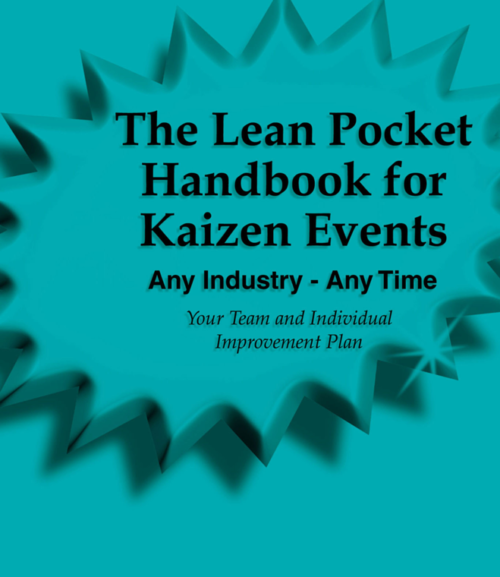 The Lean Pocket Handbook for Kaizen Events is your personal (i.e., individual) Lean planner for the 21st century. We have found individuals that use this pocket handbook feel more part of the Kaizen team. They also continue to contribute improvement ideas well past the formal team Kaizen Event. That is what Lean is all about - making those small, incremental, improvements daily (i.e., hour-by-hour and minute-by-minute) by those closest to the process.This handbook is designed to be:
The Lean Pocket Handbook for Kaizen Events is your personal (i.e., individual) Lean planner for the 21st century. We have found individuals that use this pocket handbook feel more part of the Kaizen team. They also continue to contribute improvement ideas well past the formal team Kaizen Event. That is what Lean is all about - making those small, incremental, improvements daily (i.e., hour-by-hour and minute-by-minute) by those closest to the process.This handbook is designed to be:- A quick-reference guide. Lean tools are explained in more detail in other manuals or by your facilitator during the instruction portion of the workshop.
- Your individual (i.e., personal) log. When working outside the formal training class, notes and ideas about the area or process that are being analyzed can be easily written down in this handbook (serving as your personal log) so as not to lose valuable process information.
- Your personal Kaizen planner. Kaizen Events will require that individual tasks be assigned to team members to be completed prior to the next meeting. Many of these tasks will need to be scheduled within the individual’s current work day. This handbook will thus serve as your “planner” to assure these tasks are adequately planned and completed on time.
- A tool to self-initiate Idea Kaizens. An Idea Kaizen is an individual that implements an improvement with little or no assistance or resource required. This is similar to a Suggestion Program submission; however, the individual with the Idea Kaizen would be responsible for immediate implementation of the idea.
- A learning tool. Each tool will have illustrations to graphically represent the essence of each tool. This will allow you to better understand and learn about each tool prior to using them in your Kaizen Event.

